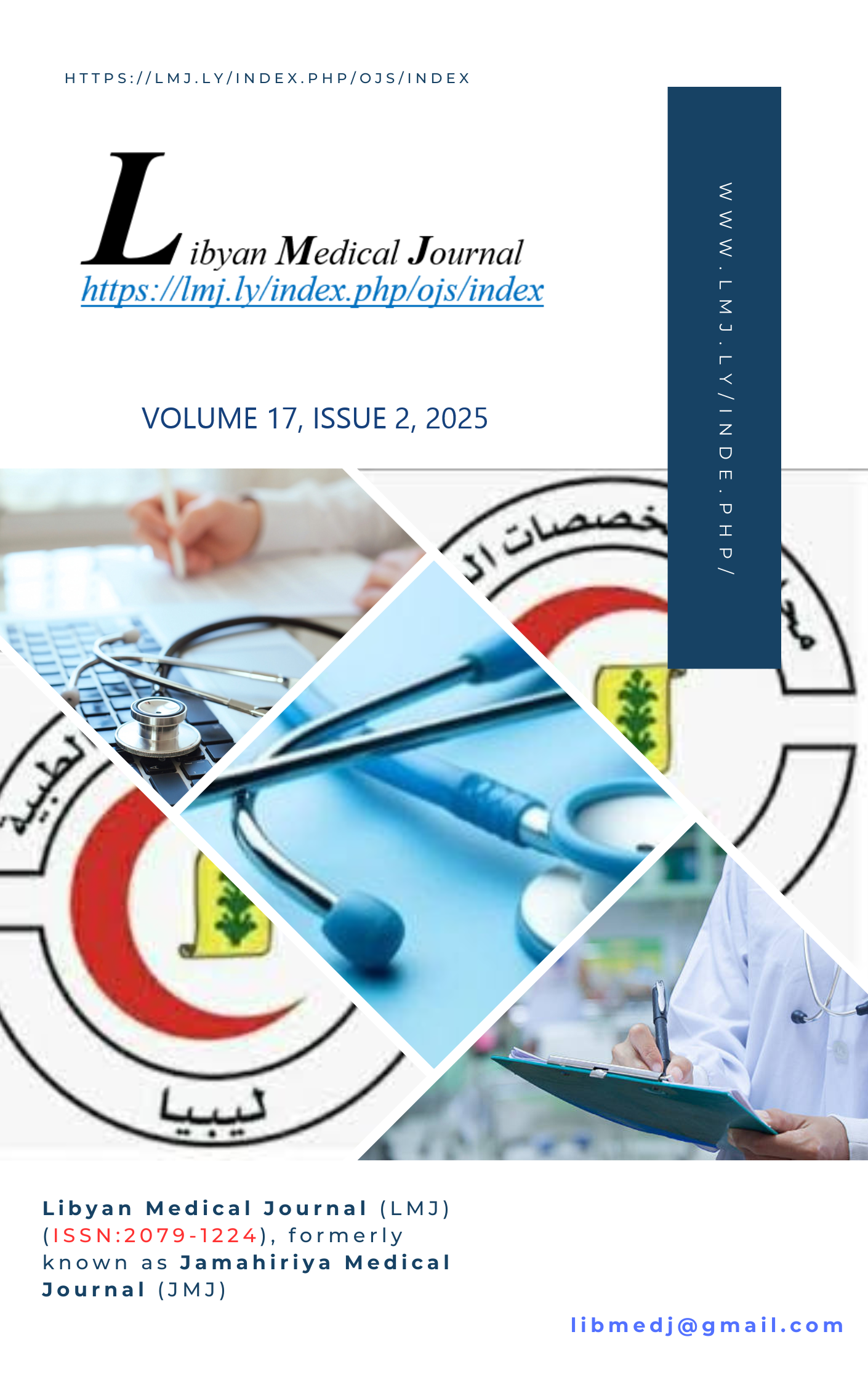Anterior Teeth Fluorosis: Insights and Concepts about Prevalence, Pathogenesis, Diagnosis, and Prevention
DOI:
https://doi.org/10.69667/lmj.2517207Keywords:
Dental Fluorosis; Anterior Teeth; Fluoride Exposure; Mitochondrial Dysfunction.Abstract
Dental fluorosis is a developmental disturbance of enamel caused by excessive fluoride intake during tooth formation, particularly between the ages of 20 to 36 months. This condition manifests primarily as aesthetic alterations, especially in anterior teeth, ranging from mild white striations to severe brown stains and enamel pitting. Fluoride, found naturally in water and various food sources, becomes harmful when ingested in excess, particularly in regions with high natural fluoride levels, such as parts of Pakistan. The severity of dental fluorosis depends on several factors, including fluoride concentration, duration of exposure, nutritional status, and genetic predisposition. The pathophysiology involves disrupted ameloblast function and altered calcium signaling, often resulting in porous, hypo-mineralized enamel. Despite fluoride’s well-documented benefits in caries prevention, its excessive intake has been epidemiologically linked to increased fluorosis prevalence. Accurate diagnosis involves clinical examination and consideration of systemic fluoride history. Preventive strategies include controlling fluoride exposure in early childhood, particularly through safe water consumption and appropriate use of fluoridated products. Current treatment is largely aesthetic, involving procedures like micro-abrasion and bleaching. Future research is needed to further understand the molecular mechanisms of fluorosis and explore novel prevention and therapeutic approaches.
References
Hidalgo-Gato FI, Duque De Estrada RJ, Félix MH, Domingo ZDJ. Fluorosis dental: no solo un problema estético. Rev Cubana Estomatol. 2007;44(4):1-12.
Siddiq K, Dost S, Naseem A, Arshad A, Ullah A. Prevalence of Dental Fluorosis in Mianwali and Mardan Districts. Journal of Cosmetics, Dermatological Sciences and Applications, 2011, 1, 106-109.
J. A. Alvarez, K. Mayra, P. C. Rezende, S. M. S. Marocho, F. B. T. Alves, P. Celiberti and A. L. Ciamponi, “Dental Fluorosis, Exposure, Arevention and Management,” Journal of Clinical and Experimental Dentistry, Vol. 1, No. 1, 2009, pp. e14-e18.
Rodrigues CRMD, Ramires-Romito ACD, Zardetto CC. Abordagem Educative Preventiaem Odon- topediatria,” In: R. J. A. Cardoso and E. A. N. Gonclaves, Odontopediatria, Arte Ciencia. Sao Paulo. 2002; pp. 113- 136.
B. A. Burt. The Changing Patterns of Systemic Fluoride Intake. Journal of Dental Research. 1992; Vol. 71, No. 5:1228-1237.
Fung KF, Zhang ZQ, Wong JW, Wong MH. Fluoride Contents in Tea and Soil from Tea Plantations and the Release of Fluoride into Tea Liquor during Infusion. Environmental Pollution. 1999; Vol. 104, No. 2, 197-205.
Cao J, Luo SF, Liu JW, Li YH. Safety Evaluation on Fluoride Content in Black Tea. Food Chemistry. 2004; Vol. 88, No. 2, 233-236.
Portillo F, Rosas Alcaraz VM, Gámez Valenzuela J, Molina Ángulo IF, Gonzáles Jiménez MV, Olivas Velázquez AK. Dental fluorosis: a review. Int J Res Med Sci [Internet]. 2024 Mar. 6 [cited 2025 Apr. 25];12(4):1306-10.
Pendrys DG. Risk of enamel fluorosis in nonfluoridated and optimally fluoridated populations: considerations for the dental professional. JADA 2000;131:746–55.
Grobler SR, Louw AJ, Van W, Kotze TJ. Dental fluorosis and caries experience in relation to three different drinking water fluoride levels in South Africa. Int J Paediatr Dent 2001;11:372–9.
Whelton HP, Ketley CE, Mc Sweeney F, O`Mullane DM. A review of fluorosis in the European Union: prevalence, risk factors and aesthetic issues. Community Dent Oral Epidemiol 2004;32 9–18.
Binbin W, Baoshan Z, Cheng Z, Guangquian Y, Xiaojing L. Relationship between fluorine in drinking water and dental health of residents in some large cities in China. Environ Int 2004;30:1067–73.
World Health Organisation. Fluorides in drinking-water. In: Bailey K, Chilton J, Dahi E, Lennon M, Jackson P, Fawell J, editors. WHO drinking-water quality series. London, UK: IWA Publishing; 2006.
Viswanathan G,Jaswanth A, GopalakrishnanS, Sivailango S. Mapping of fluoride endemic areas and assessment of fluoride exposure. Sci Total Environ 2009;407:1579–87.
Mandinic Z, Curcic M, Antonijevic B, Lekic CP, Carevic M. Relationship between fluoride intake in Serbian children living in two areas with different natural levels of f luorides and occurrence of dental fluorosis. Food Chem Toxicol. 2009;47:1080–4.
KonoK, YoshidaY, Watanabe M, Orita Y, Dote T, Bessho Y. Urine, serumand hair monitoring of hydrofluoric acid workers. Int Arch Occup Environ Health. 1993; 65:S95–8.
Hać E, Czarnowski W, Gos T, Krechniak J. Lead and fluoride content in human bone and hair in the Gdańsk region. Sci Total Environ 1997;206:249–54.
Almahrog A, Graf Y, Jbireal JM. Enamel Hypoplasia and Dental Caries in Children: A Review Study. Alq J Med App Sci [Internet]. 2025 Mar. 3 [cited 2025 Apr. 18]:373-9.
Sozan Mohammed, Ahmed Zahmoul, Jbireal J M. An Overview on the Relation Between Blood Disorders, Periodontitis and Dental Caries. Alq J Med App Sci [Internet]. 2025 Jan. 4 [cited 2025 Apr. 18];:36-42.
Yeung CA. Asystematic review of the efficacy and safety of fluoridation. Evid Based Dent.2008;9(2):39-43.
Spencer A, Australian Research Centre for Population Oral Health. The use of fluorides in Australia: guidelines. Aust Dent J. 2006;51(2):195-199.
Community Preventive Services Task Force. Preventing dental caries: community water fluoridation. Updated January 23, 2017. AccessedDecember13,2022.
Griffin SO, Regnier E, Griffin PM, Huntley V. Effectiveness of fluoride in preventing caries in adults. J Dent Res. 2007;86(5):410-415.
McDonagh MS, Whiting PF, Wilson PM, Sutton AJ, Chestnutt I, Cooper J, Misso K, Bradley M, Treasure E, Kleijnen J. Systematic review of water fluoridation. BMJ. 2000 Oct 7;321(7265):855-9.
Truman BI, Gooch BF, Sulemana I, Gift HC, Horowitz AM, Evans CA. Reviews of evidence on interventions to prevent dental caries, oral and pharyngeal cancers, and sports-related craniofacial injuries. Am J Prev Med. 2002 Jul;23(1 Suppl):21-54.
Centers for Disease Control and Prevention. Laboratory procedure manual. October 27,2014. Accessed November25,2022.
Iheozor-Ejiofor Z, Worthington HV, Walsh T, O'Malley L, Clarkson JE, Macey R, Alam R, Tugwell P, Welch V, Glenny AM. Water fluoridation for the prevention of dental caries. Cochrane Database Syst Rev. 2015 Jun 18;2015(6):CD010856.
Mohammadi AA, Yousefi M, Yaseri M, Jalilzadeh M, Mahvi AH. Skeletal fluorosis in relation to drinking water in rural areas of West Azerbaijan, Iran. Sci Rep. 2017 Dec 11;7(1):17300.
Demelash H, Beyene A, Abebe Z, Melese A. Fluoride concentration in ground water and prevalence of dental fluorosis in Ethiopian Rift Valley: systematic review and meta-analysis. BMC Public Health. 2019 Oct 16;19(1):1298.
Mohammadi AA, Yousefi M, Yaseri M, Jalilzadeh M, Mahvi AH. Skeletal fluorosis in relation to drinking water in rural areas of West Azerbaijan, Iran. Sci Rep. 2017 Dec 11;7(1):17300.
Yousefi M, Asghari FB, Zuccarello P, Oliveri Conti G, Ejlali A, Mohammadi AA, Ferrante M. Spatial Distribution Variation and Probabilistic Risk Assessment of Exposure to Fluoride in Ground Water Supplies: A Case Study in an Endemic Fluorosis Region of Northwest Iran. Int J Environ Res Public Health. 2019 Feb 15;16(4):564.
Bhagavan SV, Raghu V. Utility of check dams in dilution of fluoride concentration in ground water and the resultant analysis of blood serum and urine of villagers, Anantapur District, Andhra Pradesh, India. Environ Geochem Health. 2005 Feb;27(1):97-108.
Chuah CJ, Lye HR, Ziegler AD, Wood SH, Kongpun C, Rajchagool S. Fluoride: A naturally-occurring health hazard in drinking-water resources of Northern Thailand. Sci Total Environ. 2016 Mar 1;545-546:266-79.
Chouhan S, Flora SJ. Arsenic and fluoride: two major groundwater pollutants. Indian J Exp Biol. 2010 Jul;48(7):666 78.
Abanto JA, Rezende KMPC, Marocho SMS, Alves FBT, Celiberti P, Ciamponi AL. Dental fluorosis: Exposure, prevention and management. J Clin Exp Dent. 2009;1(1):e14-18.
Dean HT. Chronic endemic dental fluorosis (mottled enamel). J Am Med Assoc 1936; 107(16): 1269-1273.
Khan ZN, Sabino IT, de Souza Melo CG, Martini T, da Silva Pereira HAB, Buzalaf MAR. Liver Proteome of Mice with Distinct Genetic Susceptibilities to Fluorosis Treated with Different Concentrations of F in the Drinking Water. Biol Trace Elem Res. 2019 Jan;187(1):107-119.
Wei W, Pang S, Sun D. The pathogenesis of endemic fluorosis: Research progress in the last 5 years. J Cell Mol Med. 2019 Apr;23(4):2333-2342.
Mascarenhas AK. Risk factors for dental fluorosis: a review of the recent literature. Pediatr Dent. 2000 Jul-Aug;22(4):269-77.
DenBesten P, Li W. Chronic fluoride toxicity: dental fluorosis. Monogr Oral Sci. 2011;22:81-96.
Fejerskov O, Thylstrup A, Larsen MJ. Clinical and structural features and possible pathogenic mechanisms of dental fluorosis. Scand J Dent Res. 1977 Nov;85(7):510-34
Peariasamy K, Anderson P, Brook AH. A quantitative study of the effect of pumicing and etching on the remineralization of enamel opacities. Int J Paediatr Dent. 2001 May;11(3):193-200.
DenBesten PK, Yan Y, Featherstone JD, Hilton JF, Smith CE, Li W. Effects of fluoride on rat dental enamel matrix proteinases. Arch Oral Biol. 2002 Nov;47(11):763-70.
Gu LS, Wei X, Ling JQ. Etiology, diagnosis, prevention and treatment of dental fluorosis. Zhonghua Kou Qiang Yi Xue Za Zhi. 2020 May 09;55(5):296-301.
Farid H, Khan FR. Clinical management of severe fluorosis in an adult. BMJ Case Rep. 2012 Dec 10;2012.
Mascarenhas AK. Risk factors for dental fluorosis: a review of the recent literature. Pediatr Dent. 2000 Jul-Aug;22(4):269-77.
Aoba T, Fejerskov O. Dental fluorosis: Chemistry and biology. Crit Rev Oral Biol Med. 2002; 13(2):155-170.
Kumar N, Gauba K, Goyal A, Kapur A. Comparative evaluation of three different recording criteria of dental fluorosis in a known endemic fluoride area of Haryana. Indian J. Med. Res. 2018; 147 (6), 567–572.
Aguilar-Diaz FDC, Morales-Corona F, Cintra-Viveiro A. C, Fuente-Hernandez J. Prevalence of dental fluorosis in Mexico 2005-2015: A literature review. Salud Publica Mex. 2017; 59 (3), 306–313.
Tefera N, Mulualem D, Baye K, Tessema M, Woldeyohannes M, Yehualashet A, et al. Association between dietary fluoride and calcium intake of school-age children with symptoms of dental and skeletal fluorosis in halaba, southern Ethiopia. Front. Oral Health. 2022; 3–853719.
Li L, Liu X, Tao N, Chen Q, Sun Z, Yang Q, et al. Dietary carotenoid intake and dental fluorosis in relation to SOD2 (rs 11968525) polymorphisms in Guizhou, China. Asia Pac J. Clin. Nutr. 2022b; 31 (2), 320–330.
Pindborg JJ. Aetiology of developmental enamel defects not related to fluorosis. Int Dent J. 1982; 32:123-134.
Whitford GM. Determinants and mechanisms of enamel fluo rosis. Ciba Foundation Symp 205. Chichester: Wiley. 1997; pp. 226-241.
Fejerskov O, Manji F, Baelum V, Moller IJ. Dental fluorosis. A handbook for health workers. Copenhagen: Munksgaard. 1988.
Pendrys D (1999). The differential diagnosis of fluorosis. J Public Health Dent 59:235-238.
Verma A, Shetty B K, Guddattu V, Chourasia M K, Pundir P. High prevalence of dental fluorosis among adolescents is a growing concern: A school based cross-sectional study from southern India. Environ. Health Prev. Med. 2017; 22 (1), 17.
Saldarriaga A, Rojas-Gualdron D, Restrepo M, Santos-Pinto L, Jeremias F. Dental fluorosis severity in children 8-12 years old and associated factors. Acta Odontol. Latinoam. 2021b; 34 (2), 156–165.
Zhang K, Lu Z and Guo X. Advances in epidemiological status and pathogenesis of dental fluorosis. Front. Cell Dev. Biol. 2023;11:1168215.
Aulestia F J, Groeling J, Bomfim G H S, Costiniti V, Manikandan V, Chaloemtoem A, et al. Fluoride exposure alters Ca(2+) signaling and mitochondrial function in enamel cells. Sci. Signal. 2020; 13 (619).
Liu X, Huang R, Gao Y, Gao M, Ruan J, Gao J. Calcium mitigates fluoride-induced kallikrein 4 inhibition via PERK/eIF2alpha/ATF4/CHOP endoplasmic reticulum stress pathway in ameloblast-lineage cells. Arch. Oral Biol. 2021;125–105093.
Edawadi AAH, Jbireal J M. Oral cancer: An overview on the role of salivary biomarkers in diagnosis and follow-up. Azzaytuna University Journal. 2024; (51): 547-67.
Gao J, Gao Z, Dang F, Li X, Liu H, Liu X, et al. Calcium promotes differentiation in ameloblast-like LS8 cells by downregulation of phosphatidylinositol 3 kinase/protein kinase B pathway. Arch. Oral Biol. 2020;109–104579.
Crenshaw MA, Bawden JW, Proteolytic activity in embryonic bovine secretory enamel, in Tooth Enamel IV, Fearnhead RW, Suga S, Eds. (Elsevier Science, 1984) pp. 109–113.
Eckstein M, Vaeth M, Fornai C, Vinu M, Bromage TG, Nurbaeva MK, et al. Store-operated Ca2+ entry controls ameloblast cell function and enamel development. JCI Insight. 2017; 2, e91166.
Eckstein M, Vaeth M, Aulestia FJ, Costiniti V, Kassam SN, Bromage TG, et al. Differential regulation of Ca2+ influx by ORAI channels mediates enamel mineralization. Sci. Signal 2019; 12, eaav4663.
Aoba T, Fejerskov O. Dental fluorosis: Chemistry and biology. Crit. Rev. Oral Biol. Med 13, 155–170 (2002).
DenBesten PK, Biological mechanisms of dental fluorosis relevant to the use of fluoride supplements. Community Dent. Oral Epidemiol. 1999; 27, 41–47.
Bronckers ALJJ, Lyaruu DM, DenBesten PK. The impact of fluoride on ameloblasts and the mechanisms of enamel fluorosis. J. Dent. Res. 2009; 88: 877–893 (2009).
Robinson C, Connell S, Kirkham J, Brookes SJ, Shore RC, Smith AM. The effect of fluoride on the developing tooth. Caries Res. 2004; 38, 268–276.
Everett ET, Yin Z, Yan D, Zou F, Fine mapping of dental fluorosis quantitative trait loci in mice. Eur. J. Oral Sci. 2011; 119 (suppl. 1), 8–12.
Lacruz RS, Habelitz S, Wright JT, Paine ML, Dental enamel formation and implications for oral health and disease. Physiol. Rev. 2017; 97, 939–993.
Buzalaf MAR, Whitford GM, Fluoride metabolism. Monogr. Oral Sci. 2011; 22, 20–36.
McDonagh MS, Whiting PF, Wilson PM, Sutton AJ, Chestnutt I, Cooper J, et al. Systematic review of water fluoridation. BMJ. 2000; 321:855-9.
Ritter AV. Ritter. Talking with patients. Dental Fluorosis. J Esthet Restor Dent 2005; 17:326–327.
Patidar D, Sogi S, Patidar DC, Sharma A, Jain M, Prasad P. Enlightening Diagnosis and Differential Diagnosis of Dental Fluorosis—A Hidden Entity in a Crowd. Dent J Adv Stud. 2021; 9:14–21.
Choubisa SL, Choubisa A. A brief review of ideal bio-indicators, bio-markers and determinants of endemic of fluoride and fluorosis. J Biomed Res Environ Sci. 2021;2(10):920-925.
Spittle B. The safe exposure level to fluoride in pregnancy [editorial]. Fluoride 2021;54(1):1-4
Limeback H, Robinson C. Fluoride therapy. In: Limeback H, editor. Comprehensive preventivedentistry. Ames, Iowa, USA; Chichester, West Sussex, UK; and Oxford, UK: Wiley-Blackwell, animprint of John Wiley & Sons; 2012. pp. 251-82
McInnes JW. Removing brown stain from teeth. Arizona Dent J 1966; 12:13-4.
Grossman, Oliet, DelRio. Endodontic practice. Bleaching of discolored teeth. 11th ed. India. Varghese Publication; 1991. p. 276.
Price RB, Loney RW, Doyle MG, Moulding MB. An evaluation of a technique to remove stains from teeth using microabrasion. J Am Dent Assoc. 2003; 134(8): 1066-71.
Limeback H, Vieira AP, Lawrence H. Improving esthetically objectionable human enamel fluorosis with a simple microabrasion technique. Eur J Oral Sci. 2006; 114(Suppl 1): 123-126.
Habbu N, Joshi N, Ramamoorthi M, Mabrukar V. Esthetic management of dental fluorosis. Int J Dent Clin. 2011; 3(2): 80-1.
Al-Jazairy Y. Management of fluorosed teeth using porcelain laminate veneers: A six-year recall case report. Saudi Dent J. 2011; 13: 106-11.
Adedara I A, Abolaji A O, Idris U F, Olabiyi B F, Onibiyo E M, Ojuade T D, et al. Neuroprotective influence of taurine on fluoride-induced biochemical and behavioral deficits in rats. Chem. Biol. Interact. 2017;261, 1–10.
Sm, S., and Mahaboob Basha, P. Fluoride exposure aggravates the testicular damage and sperm quality in diabetic mice: Protective role of ginseng and banaba. Biol. Trace Elem. Res. 2017;177 (2), 331–344.
Yu X, Chen J, Li Y, Liu H, Hou C, Zeng Q, et al. Threshold effects of moderately excessive fluoride exposure on children's health: A potential association between dental fluorosis and loss of excellent intelligence. Environ. Int. 2018;118, 116–124.











